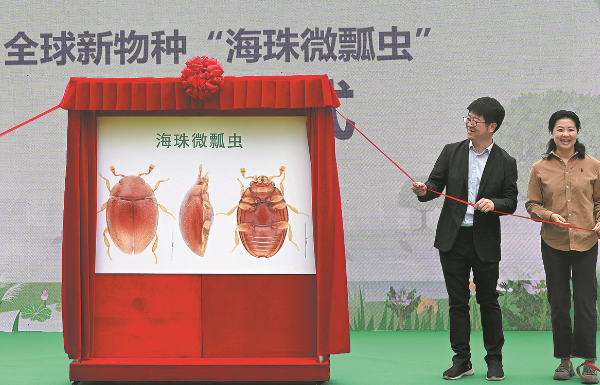Researchers discover sesame seed-sized ladybug

Details of the Haizhu Ladybug, or Eidoreus haizhuensis Liu & Li, are unveiled at a ceremony in Haizhu Wetland Park in Guangzhou, Guangdong province, on Sunday. [Photo by Chen Chuhong/CHINA NEWS SERVICE]
Chinese researchers have discovered a new micro ladybug species in Haizhu Wetland Park in Guangzhou, capital of Guangdong province, they announced on Sunday.
Named the Haizhu Ladybug, or Eidoreus haizhuensis Liu & Li, the species measures just 1.2 to 1.3 millimeters in length — about the size of a sesame seed — and is distinguished by its red-brown color, which appears lighter on its feet and antennae, and sparse yellow bristles.
The micro ladybug family, previously classified as a subfamily of the pseudo ladybug family, was recently elevated to an independent family based on molecular data. Globally, only seven genera and 19 species of micro ladybugs have been identified, most of them confined to specific islands in Central and South America and South Africa.
The Haizhu Ladybug was discovered during a 2022 insect survey in Haizhu Wetland Park, an urban oasis in Guangzhou's Haizhu district. Researchers collected more than 500,000 insect specimens during the survey and examined tens of thousands under a stereomicroscope before identifying the new species.
Yu Yali, a researcher with the Institute of Zoology at the Guangdong Academy of Sciences, said the ladybug's tiny size makes it exceptionally difficult to find.
The discovery was made possible by Liu Zhenhua, a researcher with a doctorate in entomology. Liu relied on his expertise, solid foundation in insect taxonomy and years of experience in ecological monitoring at the park to identify the subtle differences that set the new species apart.
The finding, published in the international journal Zootaxa, highlights the success of Haizhu Wetland Park's biodiversity conservation efforts. The park previously gained attention for new species discoveries in 2021 and 2022, when researchers identified the Haizhu Firefly Leaf Beetle and the Haizhu Axis Beetle.
Fan Cunxiang, chairman of the science and technology association of the Haizhu district forestry and wetland management bureau, attributed the park's biodiversity successes to ecological restoration efforts that emphasize minimal human interference.
"Our concept aligns with the natural laws of ecosystem succession," Fan said. "With less human intervention, nature evolves on its own, allowing organisms to find their niche in the ecosystem and improving biodiversity."
The park continues to monitor ecological conditions and make dynamic adjustments to ensure restoration efforts are effective, he said.
Haizhu Wetland Park plans to use its species discoveries as a springboard for further ecological research and restoration. By leveraging the role of beneficial organisms such as the Haizhu Ladybug, the park aims to achieve multifunctional ecological development in the years ahead.
All rights reserved. Presented by China Daily

